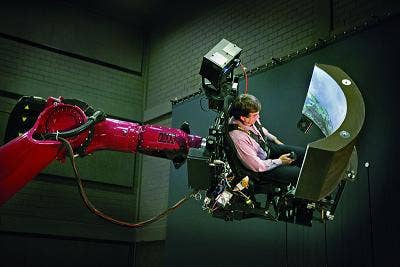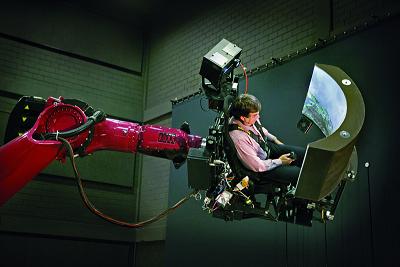Want A Great Formula 1 Simulator? Ride this Robot Arm! (video)

Share
Give engineers any excuse, and they're going to find a way to combine robots and video games. Researchers at the Max Planck Institute for Biological Cybernetics created a top notch formula one simulator, called Cyber Motion, that puts the driving at the end of an enormous industrial robot arm. Why? Because it's awesome. Oh, and there's some science, too. Racing a real F-1 car isn't like playing your average video game. There are strong forces pulling you into your seat as you round turns, and nauseating drops as you pass over hills at high speeds. Paolo Robuffo Giordana and his colleagues developed a closed loop feedback system so that the controls of the virtual car would move the robot in the right way to simulate those forces. The same robot rig has been used for flight simulators as well. Watch how riding Cyber Motion's robot arm puts you in the F-1 driver's seat in the video below. Anybody have a ticket to Germany I could borrow?
Cyber Motion's robotic arm is a modified form of the Kuka-500 called the Robocoaster, which you can see in various theme parks across the globe. As such, Giordana and his colleagues weren't providing anything extraordinary in terms of robotics, or even racing simulations (which was created using MATLAB). As they presented at ICRA 2010, the real improvement here is that they created the feedback system that translates how changes in the simulator should affect the robotic arm. You really wouldn't travel up and down five feet when in an F-1 (at least not in a turn), but that motion is what makes you feel the gees that a real formula one racer experiences. Because the Kuka-500 is a six-axis arm with a wide range of motion, and a high maximum payload, the Cyber Motion can simulate more extreme circumstances than other systems that have been created.
As we venture into creating realistic virtual reality worlds, we'll push ourselves into situations that are increasingly difficult to simulate. The work with flight and formula 1 simulators at Max Planck shows that robotics will be a key ingredient in getting you to experience the fictional world as realistically as possible. We should keep in mind, however, that the robot system in question doesn't always have to cost a million dollars. Many of you may have seen the following video earlier in the year, it shows an amazing "home-made" F-1 simulator that has robotic pistons to simulate gees in much the same way as the Cyber Motion does. Though not to the same degree. I doubt we'll ever see the Cyber Motion in your home, but this thing could fit in my living room (really, honey, it would look great with the curtains). Curiously, despite all the popularity of this home-made sim, no one seems to know exactly where it came from. Sounds like they're speaking Czech, and that may be Live for Speed on the screen, but it's anybody's guess as to the identity of the badasses who created this rig.
Be Part of the Future
Sign up to receive top stories about groundbreaking technologies and visionary thinkers from SingularityHub.


No matter which formula one simulator you prefer, it's clear that the best virtual reality is going to require some advanced robotics. That, or we need to start running wires into your brain.
[image credit: Max Planck Institute for Biological Cybernetics]
[video credits: Max Planck via IEEE Spectrum, 1981israr - original source unknown.]
[sources: Max Planck]
Related Articles

These Robots Are the Size of Single Cells and Cost Just a Penny Apiece

How Scientists Are Growing Computers From Human Brain Cells—and Why They Want to Keep Doing It

These Brain Implants Are Smaller Than Cells and Can Be Injected Into Veins
What we’re reading
